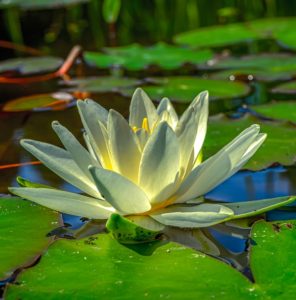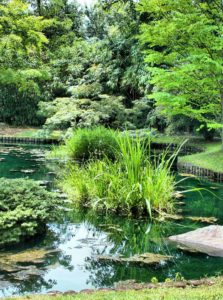Some links in the post are affiliate links and I get a commission from purchases made through some links found in the post.
Small wildlife ponds can be a wonderful feature in a garden. There are many different types of plants that can be added to a pond to enhance the appearance.
Ponds of any size need plants to keep the water clear and algae free. These plants are divided into three categories, namely:
1) Plants which provide oxygen
2) Plants for deeper water
3) Marginal plants
For the best conditions in your small wildlife pond, you need a combination of them all. For a good ecosystem in your pond, you need to have a well-balanced plant selection.
Deep water plants grow in water which is deeper. These plants do well with their roots submerged in soil at the bottom of the pond. They should have at least 50cm of water over the top of the soil.
Marginal plants are those which you will find around the edges of a pond. They are normally grown on a shelf system which keep them in the shallow water of the pond.
If you have a small pond we have written an article on the best marginal plants for small ponds here!
For these plants you may want to keep them growing in mesh crates so you can move them around if you choose.
Let’s talk about oxygenating plants as these are the plants that will primarily keep the water free from algae.
What are Oxygenating Plants?

Oxygenating plants grow under the water in the pond and take their nutrients from the water into their leaves. They then release oxygen which helps to keep water clear and algae to a minimum.
The rate of growth for these plants depends on the amount of light they receive, the water temperature, which needs to be between 12-25 degrees C, and the CO2 content of the water.
If you find that your oxygenating plants are not doing as well as they should you may want to test the water quality to ensure that the CO2 is not too low.
What are the Best Oxygenating Plants for Small Wildlife Ponds?
The following 8 plants are the best oxygenating plants for small wildlife ponds to help your pond thrive and make it look beautiful.
1) Eelgrass (Vallisneria)
Eelgrass is probably the most common plant used in aquariums, so you have most likely already seen it before. It makes a great plant for small wildlife ponds.
It can grow up to 6’ in height and provides excellent oxygenation. The plant thrives in either full sun or partial shade.
2) Spiked Water Milfoil (Myriophyllum spicatum)
The spiked water milfoil plant can grow in very deep water with the feathery parts just below the surface. This provides a great habitat for tadpoles and other small water creatures.
You will find small red flowers growing in the summer. It will do well in full sunlight.
3. Water Crowfoot (Ranunculus aquatilis)
The water crowfoot is an interesting plant as it has two different types of leaf. Under the water you will find spiked leaves while floating on top of the water there are lobed, toothed leaves.
It has small flowers in May and grows well in full sun.
4. Water Mint (Mentha aquatica)
Even though this is an excellent oxygenating plant the water mint is also classed as a marginal one because it grows best in the shallow waters.
The leaves are fragrant smelling, and clusters of pink flowers come out in the summer months. These attract pollinators. The plant grows in either sun or shade conditions.
5. Arrowhead (Sagittaria sagittifolia)
The arrohead plant thrives in water which is between 10cm – 50cm deep. It is named after the leaves which are shaped like arrowheads, and it has white flowers which come out in summer.
This is another plant that attracts dragonfly nymphs. A point with this plant is that the deeper you plant it the larger the leaves will be. It does best in deeper water and can take sun or partial shade.
You may also like: How to fix your arrowhead plant problems
6) Water Forget-me-not (Myosotis scorpiodes)
You can use the water forget-me-not plant in either deep water or as a marginal oxygenating plant. It does very well in wet soil and can even grow under the water.
It is popular with newts who lay their eggs in the leaves. This plant can be placed in either sun or shade, it is very versatile.
7) Anacharis (Elodea Densa)
The anacharis is a fast-growing oxygenating plant which is a good place for fish to hide. It is also a good source of fish food for them. Once you have planted these plants they will root rapidly and grow upwards.
8) Red Ludwigia (Ludwigia Repens)
For that added colour in your wildlife pond you should have one of these. The colour is stunning with the leaves changing to a deep red in direct sunlight.
Once rooted the red ludwigia will grow rapidly. It can grow in water as shallow as 2” so can be used as a marginal plant or a deep-water plant.
How do I put Oxygenation Plants in my Pond?
 In most man-made ponds there is a liner at the bottom which will stop your plants from rooting.
In most man-made ponds there is a liner at the bottom which will stop your plants from rooting.
It is important that you add things like coarse sand and gravel to the bottom. Even clay pellets will work if the plants have something to root in.
If you have steps or shelves you will be able to place baskets on them to keep some plants in the shallow edges. With baskets you can move the plants around if needed.
Make sure that all your plants are set in water which is of good quality, namely hard water which is rich in minerals. There should also be enough CO2.
Once your pond is completed you should let it stand for around 4 weeks so that micro-organisms can develop. A newly installed wildlife pond will lack these at the beginning, and this will result in an inadequate supply of CO2.
Ideally your plants should be added to the pond during their growth period which is between April and June.
How Many Oxygenating Plants do you Need for a Pond?
Ideally you should plant 3 bunches of oxygenating plants per square metre so in an 8 square metre pond you will need to plant 21 bunches of plants.
It is also a good idea to plant different varieties for maximum diversity. Don’t be tempted to add topsoil to the pond because this will only pollute the water.
Regular children’s sandpit sand will work well as it is inert. Washed gravel is also inert and works well.
Final Thoughts: What are the Best Oxygenating Plants for Small Wildlife Ponds?
If you’ve always thought that having a small wildlife pond would not work in your garden – think again!
With a little bit of preparation, you can have a truly beautiful habitat for many different creatures, as well as a centrepiece of beauty, even in a small garden.
Before you go, here are some more related articles I encourage you to read below to help solve more of your gardening issues:
The top 12 outdoor plants that reduce air pollution
Best 10 House Plants for Aquaponics

